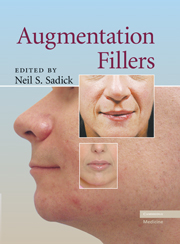Book contents
- Frontmatter
- Contents
- LIST OF CONTRIBUTORS
- Ch. 1 Application of Fillers
- Ch. 2 Approach to Choosing the Ideal Filler
- Ch. 3 Patient Selection, Counseling, and Informed Consent
- Ch. 4 Hyaluronic Acid Skin Derivatives
- Ch. 5 Collagen Products
- Ch. 6 Radiesse
- Ch. 7 ArteFill
- Ch. 8 Augmentation Fillers in Cosmetic Dermatology: Silicone
- Ch. 9 Advanta Expanded Polytetrafluoroethylene Implants
- Ch. 10 Sculptra
- Ch. 11 Lipo Transfer
- Ch. 12 BioAlcamid®
- Ch. 13 Combination of Approaches in Augmentation Fillers in Cosmetic Dermatology
- Ch. 14 Filling Complications
- Ch. 15 Postprocedure Management and Patient Instructions
- Ch. 16 Conclusion: Future Trends in Fillers
- INDEX
- References
Ch. 4 - Hyaluronic Acid Skin Derivatives
Published online by Cambridge University Press: 26 February 2010
- Frontmatter
- Contents
- LIST OF CONTRIBUTORS
- Ch. 1 Application of Fillers
- Ch. 2 Approach to Choosing the Ideal Filler
- Ch. 3 Patient Selection, Counseling, and Informed Consent
- Ch. 4 Hyaluronic Acid Skin Derivatives
- Ch. 5 Collagen Products
- Ch. 6 Radiesse
- Ch. 7 ArteFill
- Ch. 8 Augmentation Fillers in Cosmetic Dermatology: Silicone
- Ch. 9 Advanta Expanded Polytetrafluoroethylene Implants
- Ch. 10 Sculptra
- Ch. 11 Lipo Transfer
- Ch. 12 BioAlcamid®
- Ch. 13 Combination of Approaches in Augmentation Fillers in Cosmetic Dermatology
- Ch. 14 Filling Complications
- Ch. 15 Postprocedure Management and Patient Instructions
- Ch. 16 Conclusion: Future Trends in Fillers
- INDEX
- References
Summary
EMERGENCE OF HYALURONIC ACIDS
As we age, the underlying connective tissue responsible for the skin's youthful elasticity and fullness degenerates. This degeneration is exacerbated by several factors, especially sun exposure and repeated use of underlying muscles. These factors are particularly evident in facial skin. Crow's feet, laugh lines, and smile lines are among the most common cosmetic complaints. Consequently, a fervent desire exists to employ effective and safe cosmetic treatments to bolster the underlying tissue and mitigate these changes. Injectable fillers have proven to be an effective method of achieving this goal.
The first FDA-approved cosmetic filler that generated substantial enthusiasm was collagen. These products, though effective, had substantial drawbacks, including limited longevity and concerns for allergic reaction. The demand for a filler that not only bypassed the need for allergy testing but also offered greater longevity inspired the development of additional fillers, notably hyaluronic acid agents. In December 2003, Restylane became the first FDA-approved hyaluronic acid product offered in the United States, and several others have since followed or are pending approval. Aside from longevity and low allergenicity, these newer fillers offer other advantages. Particularly valuable are their inherent ability to bind large amounts of water to further bolster rhytids and cosmetic effect.
EXAMPLES OF HYALURONIC ACIDS
Clinicians use several varieties of hyaluronic acids, including FDA-approved agents such as Restylane, Perlane, Juvederm, Hylaform, Hylaform Plus, Captique, Elevess, and Prevelle Silk. Other hyaluronic acid products, many of which are already used internationally, are expected to be approved by the FDA in the near future.
- Type
- Chapter
- Information
- Augmentation Fillers , pp. 17 - 28Publisher: Cambridge University PressPrint publication year: 2010



